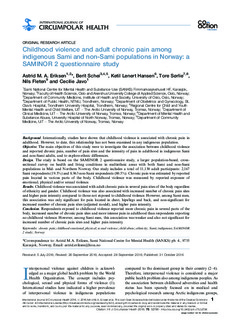| dc.contributor.author | Eriksen, Astrid M.A. | |
| dc.contributor.author | Schei, Berit | |
| dc.contributor.author | Hansen, Ketil Lenert | |
| dc.contributor.author | Sørlie, Tore | |
| dc.contributor.author | Fleten, Nils | |
| dc.contributor.author | Javo, Cecilie | |
| dc.date.accessioned | 2017-04-10T10:34:37Z | |
| dc.date.available | 2017-04-10T10:34:37Z | |
| dc.date.created | 2016-11-04T11:07:37Z | |
| dc.date.issued | 2016 | |
| dc.identifier.citation | International Journal of Circumpolar Health. 2016, 75 (1), . | nb_NO |
| dc.identifier.issn | 1239-9736 | |
| dc.identifier.uri | http://hdl.handle.net/11250/2437288 | |
| dc.description.abstract | Objective
The main objectives of this study were to investigate the association between childhood violence and reported chronic pain, number of pain sites and the intensity of pain in adulthood in indigenous Sami and non-Sami adults, and to explore ethnic differences.
Design
The study is based on the SAMINOR 2 questionnaire study, a larger population-based, cross-sectional survey on health and living conditions in multiethnic areas with both Sami and non-Sami populations in Mid- and Northern Norway. Our study includes a total of 11,130 adult participants: 2,167 Sami respondents (19.5%) and 8,963 non-Sami respondents (80.5%). Chronic pain was estimated by reported pain located in various parts of the body. Childhood violence was measured by reported exposure of emotional, physical and/or sexual violence.
Results
Childhood violence was associated with adult chronic pain in several pain sites of the body regardless of ethnicity and gender. Childhood violence was also associated with increased number of chronic pain sites and higher pain intensity compared to those not exposed to childhood violence. However, among Sami men, this association was only significant for pain located in chest, hips/legs and back, and non-significant for increased number of chronic pain sites (adjusted model), and higher pain intensity.
Conclusion
Respondents exposed to childhood violence reported more chronic pain in several parts of the body, increased number of chronic pain sites and more intense pain in adulthood than respondents reporting no childhood violence. However, among Sami men, this association was weaker and also not significant for increased number of chronic pain sites and higher pain intensity. | nb_NO |
| dc.language.iso | eng | nb_NO |
| dc.publisher | Taylor and Francis | nb_NO |
| dc.rights | Navngivelse 4.0 Internasjonal | * |
| dc.rights.uri | http://creativecommons.org/licenses/by/4.0/deed.no | * |
| dc.title | Childhood violence and adult chronic pain among indigenous Sami and non-Sami populations in Norway: a SAMINOR 2 questionnaire study | nb_NO |
| dc.type | Journal article | nb_NO |
| dc.type | Peer reviewed | nb_NO |
| dc.source.pagenumber | 12 | nb_NO |
| dc.source.volume | 75 | nb_NO |
| dc.source.journal | International Journal of Circumpolar Health | nb_NO |
| dc.source.issue | 1 | nb_NO |
| dc.identifier.doi | 10.3402/ijch.v75.32798 | |
| dc.identifier.cristin | 1397280 | |
| dc.description.localcode | © 2016 Astrid M. A. Eriksen et al. This is an Open Access article distributed under the terms of the Creative CommonsAttribution 4.0 International License (http://creativecommons.org/licenses/by/4.0/), allowing third parties to copy and redistribute the material in any medium or formatand to remix, transform, and build upon the material for any purpose, even commercially, provided the original work is properly cited and states its license | nb_NO |
| cristin.unitcode | 194,65,20,0 | |
| cristin.unitname | Institutt for samfunnsmedisin | |
| cristin.ispublished | true | |
| cristin.fulltext | original | |
| cristin.qualitycode | 1 | |

